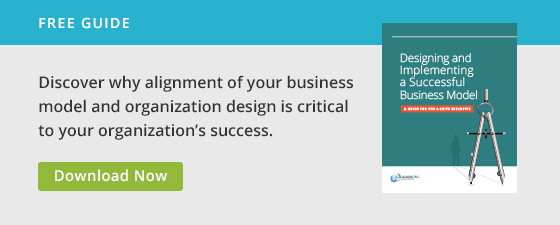I am often asked how to implement organization change. Effective implementation starts with the leadership team. The role of leadership in change management is to:
- Facilitate Change: Bringing the right people together, understanding the parts of the organization that will be affected, and knowing how to orchestrate the complexity of all of the moving parts.
- Architect Change: Establishing the processes, teams, structures, resources and systems that position the organization up to actually make the change.
- Communicate Change: Going beyond making an announcement about the new organization design. Having meaningful conversations with the entire organization, as well as those directly impacted by the change. Ensuring that everyone is aware of his or her role and contribution to the success of the organization design and strategy.
- Innovate Change: Helping the people going through the change to think innovatively about potential problems that must be solved. Ensuring that they are doing more than checking off boxes on a list of tasks that must be accomplished. Encouraging people to think creatively about the difficult issues that come up in any organizational change.
- Exemplify Change: Leading the effort by being a positive role model for the entire team and doing what is necessary to effectively implement the new organization design and strategy – both publically and privately.
We worked with a public utility several years ago to take it through a change in organization design to improve customer service, operate more efficiently and prepare for a system implementation. We took them through a process and methodology connected to strategy that cascaded down the organization. The company involved the right people, put together a good communication plan and was very successful implementing change. The secret to their success was the support of a CEO who “walked the walk” and “talked the talk.”
Another client failed in its effort to implement an organization change due to lack of buy-in from a leader on the local level. This international company had the support of a C-level executive who was located in the United States. Unfortunately, he was not present, in country often enough to ensure that the change was effectively carried out. The company created the organization design to support its strategy but stopped short there. Although it invested the time and resources into architecting the change, nothing was really accomplished because the strategy was not fully implemented. A couple of years later we were asked back to determine why the business was still struggling. By this time, the local leader had a better understanding of the marketplace and realized that the organization design and strategy that we helped the company create was on point and should be executed.
Effective leaders drive the organization design process, they are the real change leaders (change agents) who are fully engaged and committed to the strategic direction of the company. Because of their focus, these leaders have the ability to engage others in the transformation as well to successfully implement organization change. They obtain buy-in from their team by involving them in the change process from strategy through design to implementation. Equally important, these leaders let everyone know how and why their individual contribution is valued. Leaders who facilitate and architect change can effectively implement change. They are the people who “walk the walk” and encourage and motivate others to “walk” with them.






